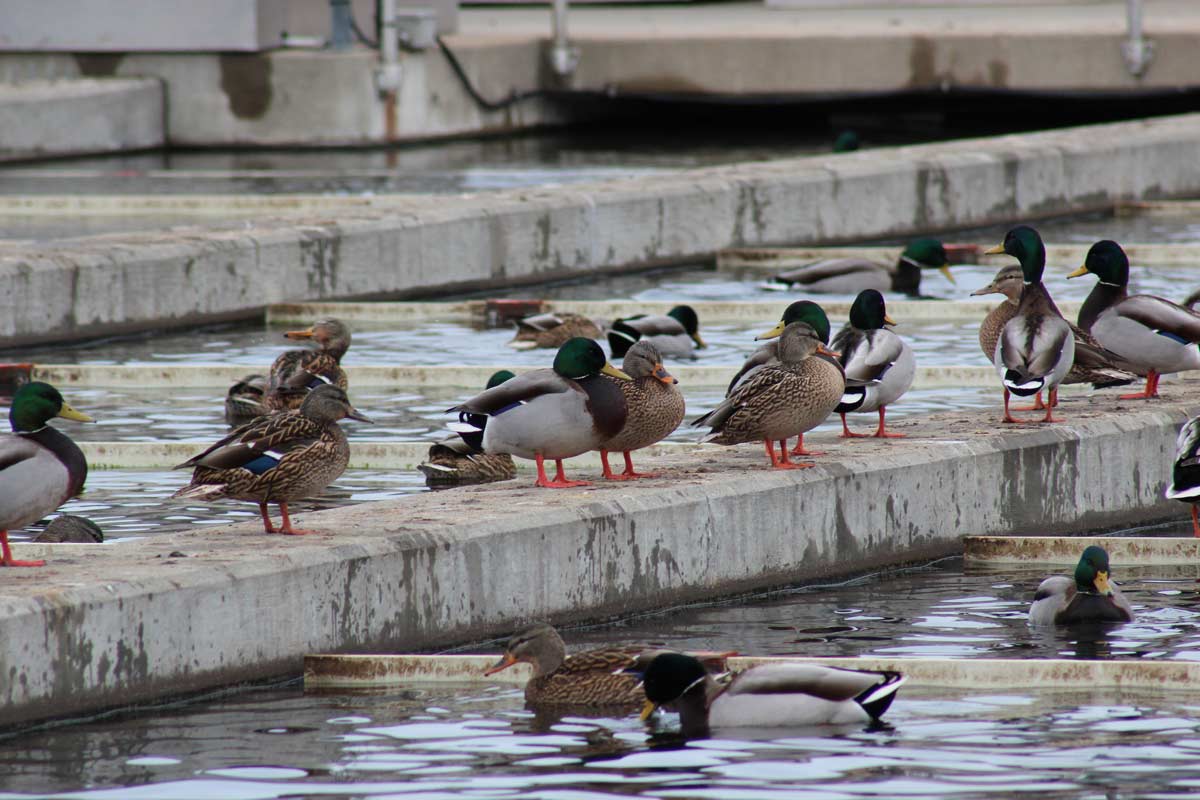A monolithic factory churning through human waste might not seem like a paradise for wildlife, but every winter this is exactly where a motley crew of mallards makes their home in Edmonton.
Eschewing the traditional migratory habits of their species, this renegade group elects instead to dwell in and around ponds of partially treated wastewater produced by the local wastewater treatment plant. Luckily for the ducks, the water here, called secondary clarified effluent water (SCEW), has already had certain undesirables filtered out. But what convinces a duck to overwinter here?
"Ducks only go however far south, or east, or west, or wherever their normal overwintering grounds are to reach appropriate conditions for them to overwinter," explains Cynthia Paszkowski, professor emeritus (biological sciences). "One thing that often creates an attractant, which was true at the water treatment plant, is open water. Not only do they feed or drink from the open water, but that's also where they often like to sleep because they're relatively safe from predators on the water."
Another factor for the birds is finding a warm spot to escape the winter cold. As a result of the treatment process, the pond water remains at a hospitable temperature (more than 10°C) all year round, even when the ambient temperature drops to a chilly -30°C during the infamous Alberta winter. The mallards seem happy to skip the cross-continental flight, but onlooking scientists are not so sure.
Hungry birds
"There was an earlier study done in the '90s where they looked at overwintering birds and a lot of the birds were not in good condition. They were pretty skinny. It's not the best place for them, clearly," says Paszkowski.
The truth is, wintering up north is probably not so much a cunning choice as a necessary evil for ducks that are unprepared to migrate. Most winter residents on the local North Saskatchewan River are juveniles, suggesting that they hatched too late in the season to build up the strength for migration. On top of that, the birds lose up to 30 per cent of their body weight over the winter. In effect, the birds find themselves in a vicious cycle: they need more food to build up the strength to make a migration, but the SCEW ponds don't have enough food for them to make it over the hurdle.
What's in the water?
With the ducks likely to stay on these ponds long-term, there remains an elephant in the room: what's in the water at the wastewater treatment plant?
"Everything," says Keith Tierney (biological sciences), an expert in toxicology and fish. "You've got all of our drugs-recreational or pharmaceutical-and you've got all of our personal care products."
Tierney and his team have also been investigating the potential toxic effects the mallards may suffer due to their prolonged exposure to the partially treated water. The researchers were mainly concerned with the potential feminizing effects of synthetic compounds in the water, such as the active ingredient in birth control-ethinyl estradiol-which has been demonstrated to affect sexual development in fish.
Luckily for the ducks, research by Tierney and his students showed that the SCEW appears to be safe. "It's full of pollutants, but they're at a very low concentration. We answered the question about toxicity, but the ecology of it, we don't know. There's going to be a relationship between mortality, starvation, and fitness benefit of overwintering, and we'd like to know what that is. But we haven't figured it out; we've only said that it exists."
Overall, the mallards might sound like quite the success story: they have found a stable niche in the urban environment, which is not the case for a lot of wildlife out there. Humans often struggle to share space with animals, resulting in animal populations being displaced, reduced, or eliminated.
But the question remains open of whether birds are truly better or worse off for wintering at the ponds, and with climate change likely to increase the number of ducks opting to stay put, this question may become more urgent in the future. The issue does not only affect Edmonton mallards: ducks and geese across the world are increasingly falling into what may be considered ecological traps: human-made micro-habitats that only work in the short term.
If the SCEW ponds are indeed a trap, how do you stop a mallard from landing there in the first place? Paszkowski suggests solutions borrowed from the fishery industry, such as wiring or netting off the ponds. Such a system might be a way to stop the cycle. To be sure what steps need to be taken, more research will be needed on the costs and benefits of an earthbound lifestyle for these urban ducks.
Sarah Nason graduated from the Faculty of Science in 2015 with a bachelor of science. Nason now works as a science communicator at Fuse Consulting Ltd.
